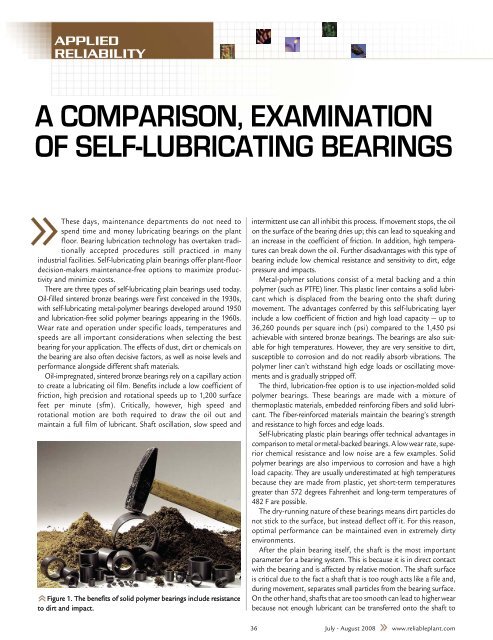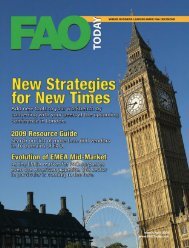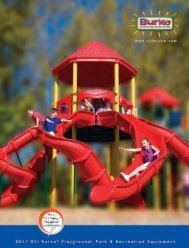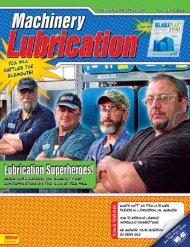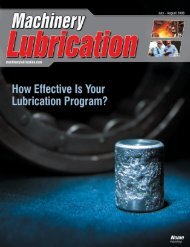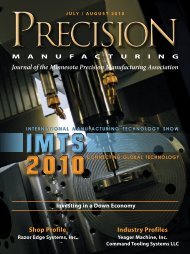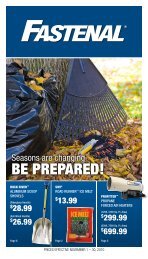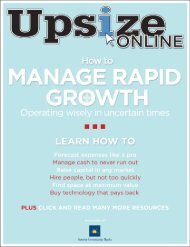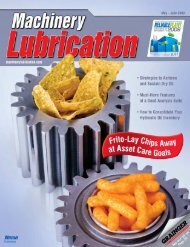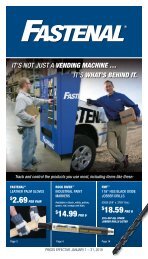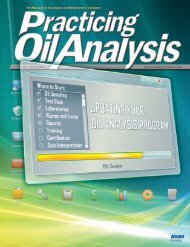Reliable Plant July August 2008
Reliable Plant July August 2008
Reliable Plant July August 2008
Create successful ePaper yourself
Turn your PDF publications into a flip-book with our unique Google optimized e-Paper software.
APPLIED<br />
RELIABILITY<br />
A COMPARISON, EXAMINATION<br />
OF SELF-LUBRICATING BEARINGS<br />
These days, maintenance departments do not need to<br />
spend time and money lubricating bearings on the plant<br />
floor. Bearing lubrication technology has overtaken traditionally<br />
accepted procedures still practiced in many<br />
industrial facilities. Self-lubricating plain bearings offer plant-floor<br />
decision-makers maintenance-free options to maximize productivity<br />
and minimize costs.<br />
There are three types of self-lubricating plain bearings used today.<br />
Oil-filled sintered bronze bearings were first conceived in the 1930s,<br />
with self-lubricating metal-polymer bearings developed around 1950<br />
and lubrication-free solid polymer bearings appearing in the 1960s.<br />
Wear rate and operation under specific loads, temperatures and<br />
speeds are all important considerations when selecting the best<br />
bearing for your application. The effects of dust, dirt or chemicals on<br />
the bearing are also often decisive factors, as well as noise levels and<br />
performance alongside different shaft materials.<br />
Oil-impregnated, sintered bronze bearings rely on a capillary action<br />
to create a lubricating oil film. Benefits include a low coefficient of<br />
friction, high precision and rotational speeds up to 1,200 surface<br />
feet per minute (sfm). Critically, however, high speed and<br />
rotational motion are both required to draw the oil out and<br />
maintain a full film of lubricant. Shaft oscillation, slow speed and<br />
Figure 1. The benefits of solid polymer bearings include resistance<br />
to dirt and impact.<br />
intermittent use can all inhibit this process. If movement stops, the oil<br />
on the surface of the bearing dries up; this can lead to squeaking and<br />
an increase in the coefficient of friction. In addition, high temperatures<br />
can break down the oil. Further disadvantages with this type of<br />
bearing include low chemical resistance and sensitivity to dirt, edge<br />
pressure and impacts.<br />
Metal-polymer solutions consist of a metal backing and a thin<br />
polymer (such as PTFE) liner. This plastic liner contains a solid lubricant<br />
which is displaced from the bearing onto the shaft during<br />
movement. The advantages conferred by this self-lubricating layer<br />
include a low coefficient of friction and high load capacity — up to<br />
36,260 pounds per square inch (psi) compared to the 1,450 psi<br />
achievable with sintered bronze bearings. The bearings are also suitable<br />
for high temperatures. However, they are very sensitive to dirt,<br />
susceptible to corrosion and do not readily absorb vibrations. The<br />
polymer liner can’t withstand high edge loads or oscillating movements<br />
and is gradually stripped off.<br />
The third, lubrication-free option is to use injection-molded solid<br />
polymer bearings. These bearings are made with a mixture of<br />
thermoplastic materials, embedded reinforcing fibers and solid lubricant.<br />
The fiber-reinforced materials maintain the bearing’s strength<br />
and resistance to high forces and edge loads.<br />
Self-lubricating plastic plain bearings offer technical advantages in<br />
comparison to metal or metal-backed bearings. A low wear rate, superior<br />
chemical resistance and low noise are a few examples. Solid<br />
polymer bearings are also impervious to corrosion and have a high<br />
load capacity. They are usually underestimated at high temperatures<br />
because they are made from plastic, yet short-term temperatures<br />
greater than 572 degrees Fahrenheit and long-term temperatures of<br />
482 F are possible.<br />
The dry-running nature of these bearings means dirt particles do<br />
not stick to the surface, but instead deflect off it. For this reason,<br />
optimal performance can be maintained even in extremely dirty<br />
environments.<br />
After the plain bearing itself, the shaft is the most important<br />
parameter for a bearing system. This is because it is in direct contact<br />
with the bearing and is affected by relative motion. The shaft surface<br />
is critical due to the fact a shaft that is too rough acts like a file and,<br />
during movement, separates small particles from the bearing surface.<br />
On the other hand, shafts that are too smooth can lead to higher wear<br />
because not enough lubricant can be transferred onto the shaft to<br />
36 <strong>July</strong> - <strong>August</strong> <strong>2008</strong> www.reliableplant.com


